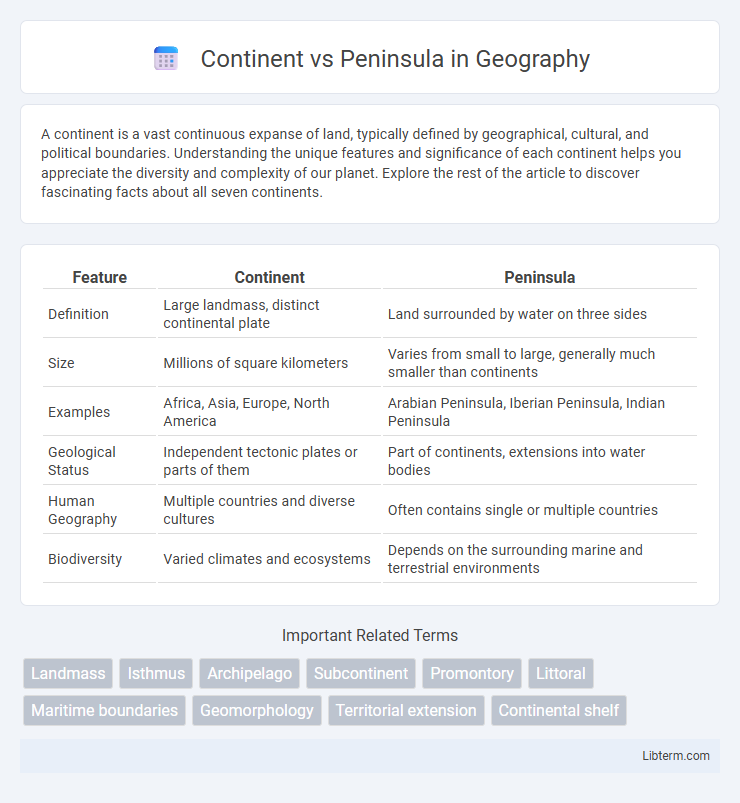A continent is a vast continuous expanse of land, typically defined by geographical, cultural, and political boundaries. Understanding the unique features and significance of each continent helps you appreciate the diversity and complexity of our planet. Explore the rest of the article to discover fascinating facts about all seven continents.
Table of Comparison
| Feature | Continent | Peninsula |
|---|---|---|
| Definition | Large landmass, distinct continental plate | Land surrounded by water on three sides |
| Size | Millions of square kilometers | Varies from small to large, generally much smaller than continents |
| Examples | Africa, Asia, Europe, North America | Arabian Peninsula, Iberian Peninsula, Indian Peninsula |
| Geological Status | Independent tectonic plates or parts of them | Part of continents, extensions into water bodies |
| Human Geography | Multiple countries and diverse cultures | Often contains single or multiple countries |
| Biodiversity | Varied climates and ecosystems | Depends on the surrounding marine and terrestrial environments |
Introduction: Understanding Continents and Peninsulas
Continents are vast, continuous landmasses typically composed of multiple countries, such as Asia, Africa, and Europe, whereas peninsulas are smaller landforms projecting into bodies of water and surrounded by water on three sides, like the Arabian Peninsula or Florida Peninsula. Understanding the differences between continents and peninsulas helps clarify geographic borders, climate zones, and cultural regions. Key factors distinguishing them include size, geological formation, and their surrounding water bodies.
Definitions: What is a Continent?
A continent is a large, continuous expanse of landmass typically defined by geographical boundaries and distinct tectonic plates, such as Asia, Africa, or Europe. It encompasses multiple countries and diverse ecosystems, often spanning millions of square kilometers. Unlike peninsulas, continents are not surrounded by water on three sides and represent one of the Earth's primary land divisions.
Definitions: What is a Peninsula?
A peninsula is a landform surrounded by water on three sides but connected to a larger landmass on one side, distinguishing it from a continent which is a vast continuous expanse of land. Peninsulas vary in size and shape, often influencing local climate and biodiversity due to their unique geographical positioning. Key examples of peninsulas include the Iberian Peninsula in Europe and the Arabian Peninsula in the Middle East.
Key Differences Between Continents and Peninsulas
Continents are vast, continuous landmasses typically comprising multiple countries and diverse ecosystems, while peninsulas are smaller landforms protruding into a body of water, surrounded by water on three sides. The primary difference lies in scale and geographic context: continents cover extensive areas and serve as major global divisions, whereas peninsulas are subdivisions of continents with distinct coastal boundaries. Understanding the geological formation, size, and hydrological characteristics helps differentiate continents from peninsulas in geographic studies.
Geographic Scale: Size and Boundaries
A continent represents a vast continuous expanse of land that covers millions of square kilometers and is distinguished by large-scale natural boundaries such as oceans and tectonic plate edges. In contrast, a peninsula is a smaller landform projecting into a body of water and is surrounded by water on three sides, with boundaries defined primarily by surrounding seas or lakes rather than tectonic divisions. The geographic scale difference makes a continent a principal global landmass, while a peninsula is a subsidiary feature within or attached to a continent.
Examples of Famous Continents
Africa, Asia, and Europe are famous continents known for their vast landmasses and diverse ecosystems. Africa is home to the Sahara Desert and the Nile River, while Asia contains the Himalayas and the world's highest peak, Mount Everest. Europe, known for its rich history and cultural heritage, includes countries like Germany, France, and Italy.
Notable Peninsulas Around the World
Notable peninsulas around the world include the Iberian Peninsula in southwestern Europe, home to Spain and Portugal, and the Arabian Peninsula, the largest peninsula, rich in oil reserves and encompassing countries like Saudi Arabia and Yemen. The Scandinavian Peninsula, covering Norway and Sweden, features extensive fjords and a rugged coastline, while the Indian Peninsula is characterized by its diverse ecosystems and significant cultural heritage. These landforms differ from continents by being smaller land extensions surrounded by water on three sides, playing crucial roles in regional climate, biodiversity, and human settlement patterns.
Formation and Geology: How Continents and Peninsulas Develop
Continents form through complex geological processes involving plate tectonics, volcanic activity, and the accumulation of continental crust over billions of years, creating large landmasses composed mainly of granite and metamorphic rocks. Peninsulas develop as extensions of continents, shaped by erosion, sediment deposition, and changes in sea levels that isolate portions of land surrounded by water on three sides. Both features reflect dynamic Earth processes, but peninsulas are more susceptible to ongoing coastal changes, while continents maintain stability due to their thick, ancient lithospheric roots.
Importance in Human History and Civilization
Continents such as Africa, Asia, and Europe have been cradles of early human civilization, enabling the development of diverse cultures, agriculture, and complex societies due to their vast landmass and resource variety. Peninsulas like the Iberian, Arabian, and Indian played crucial strategic roles in trade, migration, and cultural exchange, serving as gateways between continents and facilitating the spread of ideas, technology, and religions. The geographic features of both continents and peninsulas have significantly influenced the patterns of human settlement, economic development, and historical conflicts, shaping the trajectory of global civilization.
Conclusion: Comparing Continents and Peninsulas
Continents are vast, continuous landmasses typically containing multiple countries and diverse ecosystems, while peninsulas are smaller landforms surrounded by water on three sides yet connected to a mainland. Comparing continents and peninsulas highlights the significant differences in scale, geographical impact, and roles in human settlement patterns. Understanding these distinctions aids in geographic classification, environmental study, and regional planning strategies.
Continent Infographic

 libterm.com
libterm.com